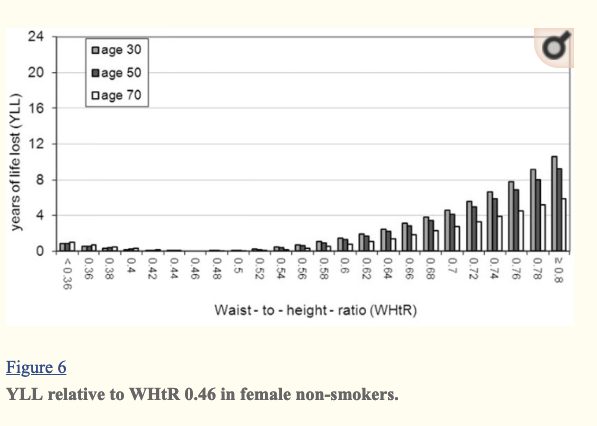How much do you know about your height-to-waist ratio, and what does it even mean for your overall health? Let me help you learn a bit more about it, how you can calculate it, and what it all means. Let’s dive into it to give you a much clearer idea of how to live your best life.
- Have any questions?
- 480-767-9018
- support@in-goodhealth.com

How to Find the Best Thyroid Levels for Your Condition
July 3, 2024
Unveiling the Healing Powers of Ashwagandha for Thyroid Disease
July 8, 2024
How to Find the Best Thyroid Levels for Your Condition
July 3, 2024
Unveiling the Healing Powers of Ashwagandha for Thyroid Disease
July 8, 2024Product Recommendation: RS Complete benefits GI health through its ability to support microbial balance and proper intestinal permeability and integrity. Additionally, this formula may help support optimal blood sugar and insulin levels, appetite control, and cardiovascular health. Click Here
Define: Anthropometric
Your height-to-waist ratio is a great example of what we call an anthropometric marker. These are ways to measure the proportions and measurements of the human body, in order to determine health risks (lifespan, too).
They are handy because they are non-invasive, easy to find out, even to the point that you could do them on your own. The question then becomes: which of the various anthropometrics are best at identifying that which we can prevent?
Pretty much all forms of chronic diseases can be found under the umbrella of “metabolic syndrome.” This might include:
- Cardiovascular Disease
- Diabetes
- Stroke
- Kidney Disease
- Fatty Liver (Read: How do you know if you have fatty liver?)
- Alzheimer’s
- Solid Cancer
These are all the main preventable causes of non-accidental and non-infectious death and disability. “The levers we can pull,” meaning the things we can do to prevent putting ourselves in the path of danger – simply with lifestyle changes.
The Truth About Weight

Of the main anthropometrics, folks will often hone in on weight. Doctors will weigh you, and we are often concerned with our weight and how it is fluctuating. The truth is that it is not a very strong predictor of metabolic syndrome.
Key Insight: Your weight is not the best marker to show whether or not these complications will happen to you – or if you are even moving closer or further away to or from risk.
In fact, a lot of people who are heavy show no signs of having metabolic syndrome – and a lot who are on the lighter side have plenty of signs. So, let’s dive deeper into our conversation by having a look at some additional markers.
Other Markers of Note
Some of the important markers to keep in mind:
- Body Mass Index (BMI)
- Waist-To-Hip Ratio
- Body Fat percentage
Body fat is a meaningful marker, but it can be difficult to get perfectly accurate home readings on a regular basis. There is also data arguing that every single person has their own threshold to where some can have a little more body fat than others and not get sick.
Then, there are also some blood markers worth keeping in mind, like:
- FGL – Morning fasting glucose level
- A1C – Hemoglobin A1C – 3-month blood sugar average
- HDL/Trig Ratio – Good cholesterol to triglyceride ratio
Your Height-To-Waist Ratio
Putting all of these markers together, your height-to-waist ratio is going to be the best early predictor of metabolic syndrome. It can also be helpful to show when you are moving away from the risk by witnessing changes.
The funny thing is that, since we have always focused a great deal of our time on weight, a lot of the “diet industry” has been guided by the principle of incentivizing weight loss. Everyone is looking for weight loss and not waist loss.
Key Insight: Returning to the healthiest version of you is going to revolve around this concept of “waist loss,” and not weight loss. That is what will really make a difference in your life.
In fact, weight loss alone only works when it is followed by waist loss. Sometimes this can be the case, but often there is not. Many may lose anywhere between 5 to 15 pounds without losing a single inch – and without getting any closer to optimal health.
Bottom Line: In cases like these we know that people who fit those mold are more at risk for metabolic syndrome (and the complications therein).
Understanding Fuel
Let’s continue our conversation by having a really clear understanding of the role fuel plays in our bodies and in our overall health (Read: How much fuel do you need?). It’s not about calories anymore. It’s about fuel.
Fuel is all of the things that your body can use for energy. Personally, I like the concept of “fuel” over “calories” for a few key reasons. First, not all calories are equal. That is because Some foods have calories, but they also have so much fiber, and so much resistant starch, that they work differently (Read: Forget carbs and fats, it is the fuel that matters).
When it comes to fuel and how much you should have, a good starting point is 6 servings throughout the day. You can break it down into a formula like this:
- Carbohydrates: 3 – 4 servings
- Fats: 2 – 3 servings
How Does Fuel Benefit You?
The benefit of getting your fuel load in its proper place include:
- Helping with energy
- Proper longevity
- Lowered risk of chronic disease
- Positive brain function
- Better digestion
Types of Fuel
What happens here is that the body has a tiered system of where fuel goes. This includes:
- Carbs
- Fat
- Ketones
- Alcohol
These are all sources of fuel, so let’s break each of them down:
Carbohydrates

The primary things that carbs bring to the table are resistant starch, fibers, polyphenols, phytonutrients (like those in intact whole grains).
Drawback is that those carbohydrates which are higher in fructose can be more difficult for the body to process.
Fats
Positive thing about fats is that they can provide us with essential fats, like omega-3s and the omega-6s. The drawbacks come from the other types of fats that we might also ingest. There are harmful trans fats and saturated fats (which can be harmful in certain amounts)
Ketones
There are two types of ketones, which are:
- Endogenous ketones (those we make)
- Exogenous (those we can ingest)
The thing that I want you to know is that we can consider ketones as fuel. This means that if your body has more than it needs, you can still turn ketones into fat. If there is less fuel total than you need, ketones are unable to make it work differently in any way.
Alcohol
I do need to mention alcohol. Alcohol is a compound that we can burn as fuel, but there is really no clear positive involved. While there might have been some previous research about alcohol and cardiovascular health, these research studies are now in dispute.
In terms of negatives, alcohol has been linked to cancer risk, brain aging, and liver disease. While it does act as a fuel, alcohol certainly works differently when compared to carbs, fats, and ketones. It really does not carry the same positives at all.
The Cascading Effects of Fat
When we first take fuel into the bloodstream it goes into the muscle tissue. Healthy muscles take it, store it, and when they cannot take anymore it goes in the subcutaneous fat (the fat under the skin).
If that is too full, and the body cannot grow more in the way of fat, it goes into the visceral fat. This is simply another place for storing fat, this time around the organs.

When the visceral fat is full, then the fat begins to spill into the organs. Then when the liver cells cannot hold it well, it goes between the cells, eventually leading to elevated levels of fuel leaking out of the liver (and is what we call “leaky liver”).
All of this is incredibly predictive of:
- Heart Attack
- Stroke
- Early Death1
Bottom Line: Your waist-to-height ratio is a proven way to know that this is happening in your body.2 More so than any of the other markers that we had discussed.
If someone is at the extremes, they can see ten years off their lifespan based on the results of their height-to-waist ratio.3 The only pitfall, though, involves smokers.

Smokers may be lighter, but not healthier. Everything that we discuss today, as it pertains to waist-to-height ratio, relates to non-smokers.
Height-To-Waist Ratio Ranges
Depending on your results, we have some ranges which can help you make sense of them:

Depending on your gender, these are going to be slightly different. This is because men typically get a little bit more leeway.
Key Insight: Interested in calculating your height-to-waist ratio right now? You are in luck! I have built a calculator for you to make the process super simple and helpful. Click here to get started right now.
The process is super simple. All you have to do is input your:
- Height
- Waist circumference
- Gender
From that, you will have the chance to learn your exact score, which of those aforementioned ranges you fall into, and how you can go about improving your ratio if it is not where you need it to be for your health.
Bottom Line: The beautiful thing is that your ratio can change, and it can change quite fast – your results today are not necessarily your results tomorrow, and you can begin feeling better almost immediately by taking the right steps to optimal health.

Find Your Results Today
I built the Metabolism Reset Diet in order to improve the height-to-waist ratio, which is why this calculator is such a neat way to find out where you are at with your health today, and what you can do to benefit your life tomorrow and into the future. Give it shot right now, and I will be seeing you with your results soon, click here.
1 – https://en.wikipedia.org/wiki/Waist-to-height_ratio#cite_note-2
2 – https://journals.plos.org/plosone/article?id=10.1371/journal.pone.0177175
3 – https://www.ncbi.nlm.nih.gov/pubmed/25198730

P.S. Whenever you are ready, here is how I can help you now:
- Schedule a Thyroid Second Opinion with me, Dr. C, Click Here for Details
- Need help to choose supplements? Click ‘Help Me Decide Here'
- Get my top books Here
Dr. Alan Glen Christianson (Dr. C) is a Naturopathic Endocrinologist and the author of The NY Times bestselling Hormone Healing Cookbook, The Metabolism Reset Diet, and The Thyroid Reset Diet.
Dr. C’s gift for figuring out what works has helped hundreds of thousands reverse thyroid disease, heal their adrenals, and lose weight naturally. Learn more about the surprising story that started his quest.









